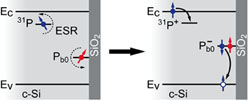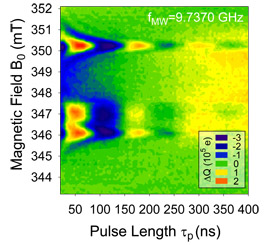|
Welcome to the Brandt group
Group leader: Prof. Dr. Martin Brandt
Donors as qubits
In semiconductors, several types of artificial atoms are actively being investigated for their application in quantum information processing. Among these are donor states such as those of phosphorus donors in silicon. Phosphorus, an atom from group V of the table of elements, has one electron more than Silicon, a group-IV atom. At low temperatures, this electron stays bound to the P donor.

Several different ways have been proposed in which either the spin of this electron or the spin of the 31P nucleus can be used as a quantum bit or qubit. Our research group investigates methods to read out the spin state of these qubits using pulsed magnetic resonance techniques. As spin-to-charge conversion, which is required to detect spin states via electrical measurements, we use the spin-dependent transfer of the donor electron to a paramagnetic state which occurs naturally at the Si/SiO2 interface, which incidentally also leads to an efficient single-shot hyperpolarization of the nuclear spins.

We have demonstrated full coherent control and readout of donor electron and nuclear spins via conductivity measurements under pulsed microwave excitation. Echo tomography is used to observe spin echos also in the electronic transport, allowing the transfer of all advanced magnetic resonance techniques such electron spin echo envelope modulation (ESEEM) to pulsed electrically detected magnetic resonance (pEDMR). The recombination-based approach used provides an on-demand ionization of the donors. Since the major electronic decoherence process of the nuclear donor spins is mediated by hyperfine interaction, this ionization vastly increases the coherence. In isotopically pure 28Si, T2s of as long as 40 minutes have been observed for these 31P+ spins.
This excellent isolation from its environment however leads to issues when trying to selectively address these ionized donor nuclei. Heavier donors such as 75As possess a quadrupole moment, which allows their nuclear spins to couple to electric field gradients generated e.g. via strain. The group is currently spearheading the investigation and application of the quadrupole physics in Silicon.
Furthermore, we are working a more technical issues such as increasing the time resolution for pEDMR via radiofrequency reflectometry. We develop antenna-based broad-band microwave delivery allowing the use of shaped, adiabatic or optimum control microwave pulses and test several approaches for the realization of an EDMR microscope.
A more introductory text into the origin of spins, their usage in modern technology, the realization of large artificial atoms in semiconductors and their application for quantum information processing can be found in chapter 10 of the WSI brochure ( English version, Kapitel 10 in deutscher Sprache).
Review
Donors for Quantum Information Processing
M.S. Brandt
Download
Selected publications
-
Electrical detection of coherent 31P spin quantum states
A.R. Stegner, C. Boehme, H. Huebl, M. Stutzmann, K. Lips, M.S. Brandt
Nature Physics 2, 835 (2006), arXiv:quant-ph/0607178v1
-
Electrically detected magnetic resonance in ion-implanted Si:P nanostructures
D.R. McCamey, H. Huebl, M.S. Brandt, W.D. Hutchison, J.C. McCallum, R.G. Clark, A.R. Hamilton
Applied Physics Letters 89, 182115 (2006)
-
Spin echoes in the charge transport through phosphorus donors in silicon
H. Huebl, F. Hoehne, B. Grolik, A.R. Stegner, M. Stutzmann, M.S. Brandt
Physical Review Letters 100, 177602 (2008)
-
Spin-Dependent Recombination between Phosphorus Donors in Silicon and Si/SiO2 Interface States Investigated with Pulsed Electrically Detected Electron Double Resonance
Felix Hoehne, Hans Huebl, Bastian Galler, Martin Stutzmann, Martin S. Brandt
Physical Review Letters 104, 046402 (2010)
-
Electroelastic Hyperfine Tuning of Phosphorus Donors in Silicon
L. Dreher, T. A. Hilker, A. Brandlmaier, S. T. B. Goennenwein, H. Huebl, M. Stutzmann, M. S. Brandt
Physical Review Letters 106, 037601 (2011)
-
Electrical Detection of Coherent Nuclear Spin Oscillations in Phosphorus-Doped Silicon Using Pulsed ENDOR
Felix Hoehne, Lukas Dreher, Hans Huebl, Martin Stutzmann, Martin S. Brandt
Physical Review Letters 106, 187601 (2011)
-
Electrically detected electron-spin-echo envelope-modulation: A highly sensitive technique for resolving complex interface structures
Felix Hoehne, Jinming Lu, Andre R. Stegner, Martin Stutzmann, Martin S. Brandt, Martin Rohrmüller, Wolf Gero Schmidt und Uwe Gerstmann
Physical Review Letters 106, 196101 (2011)
-
Nuclear Spin Dynamics of Ionized Phosphorus Donors in Silicon
Lukas Dreher, Felix Hoehne, Martin Stutzmann, Martin S. Brandt
Physical Review Letters 108, 027602 (2012)
-
Real Time Electrical Detection of Coherent Spin Oscillations
F. Hoehne, C. Huck, M. S. Brandt, H. Huebl
Physical Review B 89, 161305 (2014)
-
Mechanical tuning of ionized donor qubits in silicon
David P. Franke, Florian M. Hrubesch, Markus Künzl, Kohei M. Itoh, Martin Stutzmann, Felix Hoehne, Lukas Dreher, Martin S. Brandt
Physical Review Letters 115, 057601 (2015)
Collaborations
Funding
DFG via SFB 631 “Solid-State Quantum Information Processing”, Teilprojekt C3 “Fundamentals of Quantum Logic Gates in Silicon”, and via SPP 1601 "New Frontiers in EPR Sensitivity", Teilprojekt Br 1585/8-2.
|
|
|



 Several different ways have been proposed in which either the spin of this electron or the spin of the 31P nucleus can be used as a quantum bit or qubit. Our research group investigates methods to read out the spin state of these qubits using pulsed magnetic resonance techniques. As spin-to-charge conversion, which is required to detect spin states via electrical measurements, we use the spin-dependent transfer of the donor electron to a paramagnetic state which occurs naturally at the Si/SiO2 interface, which incidentally also leads to an efficient single-shot hyperpolarization of the nuclear spins.
Several different ways have been proposed in which either the spin of this electron or the spin of the 31P nucleus can be used as a quantum bit or qubit. Our research group investigates methods to read out the spin state of these qubits using pulsed magnetic resonance techniques. As spin-to-charge conversion, which is required to detect spin states via electrical measurements, we use the spin-dependent transfer of the donor electron to a paramagnetic state which occurs naturally at the Si/SiO2 interface, which incidentally also leads to an efficient single-shot hyperpolarization of the nuclear spins.  We have demonstrated full coherent control and readout of donor electron and nuclear spins via conductivity measurements under pulsed microwave excitation. Echo tomography is used to observe spin echos also in the electronic transport, allowing the transfer of all advanced magnetic resonance techniques such electron spin echo envelope modulation (ESEEM) to pulsed electrically detected magnetic resonance (pEDMR). The recombination-based approach used provides an on-demand ionization of the donors. Since the major electronic decoherence process of the nuclear donor spins is mediated by hyperfine interaction, this ionization vastly increases the coherence. In isotopically pure 28Si, T2s of as long as 40 minutes have been observed for these 31P+ spins.
We have demonstrated full coherent control and readout of donor electron and nuclear spins via conductivity measurements under pulsed microwave excitation. Echo tomography is used to observe spin echos also in the electronic transport, allowing the transfer of all advanced magnetic resonance techniques such electron spin echo envelope modulation (ESEEM) to pulsed electrically detected magnetic resonance (pEDMR). The recombination-based approach used provides an on-demand ionization of the donors. Since the major electronic decoherence process of the nuclear donor spins is mediated by hyperfine interaction, this ionization vastly increases the coherence. In isotopically pure 28Si, T2s of as long as 40 minutes have been observed for these 31P+ spins.